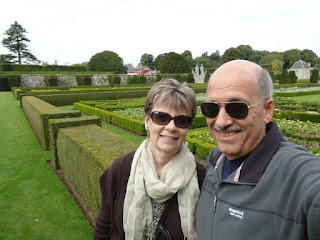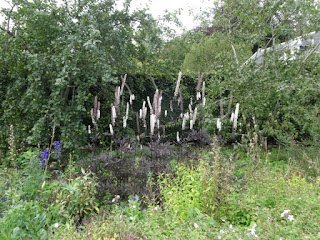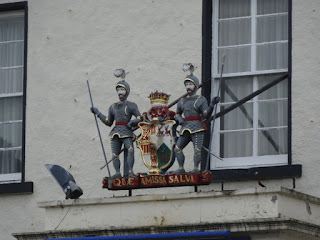Once again, we were blessed with sunny skies as we made our way out of Aberdeen, heading west and away from the coast. Believe me, we know how rare that circumstance is, and combine the blue skies with temperatures in the mid-60's and you have the perfect weather for walking in Scotland!
First stop was Pitmedden Gardens, another one of the great formal gardens of Scotland. Pitmedden was made for Sir Alexander Seton around 1675, and the walls have sheltered flowers and fruit trees for hundreds of years. In fact, the last Sunday in September is called "picking Sunday" and the apples are harvested from the trees and sold to the general public.
Just as you enter the grounds, there is a museum of farming life on the left, which has a vast collection of various farming tools used over the centuries.
These tractors immediately caught my eye:
One thing that Marty and I have noticed is that this area is obviously more conducive to planting and harvesting, as compared to grazing. We have seen cattle, occasionally, but few hills filled with sheep. Gazing along the countryside, the fields are loaded with round bales drying in the sun, obviously having been harvested sometime recently.
The grounds of Pitmedden are preserved as they would have been over the years and the farming museum is set up in some of the houses that would have been on the property. One thing that I learned about this area is that farm hands did not commit to one farmer. Rather, they changed farms about every 6 months, moving from place to place. Not conducive to genealogy, for sure!
I was quite interested in seeing this potato digger:
And here you see a seed drilling machine. It was made in Aberdeen in 1864. It is pulled by a single horse and the seeds drop down through pipes to below the soil surface.
The information was fascinating, and there was even a surprise or two.
Finally we made our way to the gardens, which were, as predicted, spectacular. There were two pavilions, one on each end, which were set up for viewing the gardens well over 300 years ago.
The ground stone work was place in memory of Sir Alexander Seton, who was shot through the heart at Brig " Dee in June 1639.
Isn't this place phenomenal?
Of course, we needed the "selfie" to show that we had been here.
As we were walking out, I snapped a photo of these two rabbits that look as if they are giving the high five sign to each other.
Which is kind of comical, as the gardens are set up so that no predators could get in.....unless a gate was left open, and even then, one would need to maneuver steps to get to the garden. Somehow, I just can't see bunnies hopping down those stone stairs.
Moving on, we headed to Fyvie Castle which has to be one of the most spectacular castles that we've seen.
This castle was a Royal Castle as far back as 1200, and there is evidence that William I stayed here as well as Alexander II, Edward I and Robert the Bruce. Robert III came to the throne in 1390 and gifted it to Sir Henry Preston. As the castle passed through history, it seemed that each owner added his own tower, resulting in the magnificent building that you can see today.
When the castle came into possession by Sir Alexander Seton, he had his tower built with a circular staircase wide enough to hold 4 horses side by side. The rise on the steps were low, as it appears that the evening entertainment was racing horses up and down the staircase to see which one could make it to the top first, and subsequently to the bottom as well.
In 1733, it was purchased by William Gordon. He added the Gordon Tower and made many of the renovations that one can see today. He also drained the moat, which resulted in a beautiful lake that sits on the grounds.
Unfortunately, Gordon ran out of money and found himself forced to sell the estate. In 1885, it was purchased by Alexander Leith, a local man who had made his fortune in the steel industry. He built the Leith Tower and filled the interior with priceless heirlooms including a room filled with original Raeburn painting.
It was certainly interesting to see the difference in the towers as we walked through the castle, and to the learn the history behind each of the owners. We learned that Fyvie Castle is one of the most haunted castles in all of Scotland.
One of the bedrooms features a window sill with an engraved name in the concrete. The legend goes that Alexander Seton was tired of his wife, Lady Meldrum, Lillian Drummond, because she would not bear him a son, so he locked her in a tower and starved her until she died. He then went onto marry his wife's niece, only 15 at the time, and on their wedding night, they were awoken to terrible scratching at the window and a horrible noise. The next day, this inscription was found on the sill. "D. Lilies Drummond."
Funny, but the chiseled granite letters are perfectly formed. I find it hard to believe that a Lady would have such skill. Not to mention that she's have to be hanging onto the wall with chisel in hand in order to accomplish this. But then again, perhaps a lady ghost has such abilities, who knows?
In any event, legend holds that there is a reappearing woman, known as the green lady who appears frequently at the castle and items are often found moved about in the morning.
After our tour, we enjoyed a lovely Cream Tea in the tearoom, and headed out to see the gardens.
There were blackberries, and currents, turnips, rhubarb, various varieties of beans. A real gardener's delight!
And there were fruit trees trained to grow up along the wall as we have seen so many places here.
Here you see a thistle, the traditional symbol of Scotland.
Then, we headed back to the car and made the drive to our B&B. This one is definitely off the beaten track and we had a wee built of difficulty finding it. But, once inside, we could see that it was well worth the effort.
We decided to head into town for dinner, but before that, we took in some of the town of Inverurie,
and headed to the cemetery on the edge of town.
There stand two mounds, known as the Bass of Inverurie.
They supported the motte and bailey castle built by the Earls of Garioch in the 1100s. The castle here was used as a base by Robert the Bruce in 1308.
All that stands today are these two mounds. Near them, in the cemetery, stand four pictish stones.
If you look closely, you can make out the carving a horse on this one.
Sorry, but I have no more explanation to offer regarding these curious stones.
I'd say that was quite a full day, and I'm going to call this quits for now. A glass of Prosecco is calling my name!
First stop was Pitmedden Gardens, another one of the great formal gardens of Scotland. Pitmedden was made for Sir Alexander Seton around 1675, and the walls have sheltered flowers and fruit trees for hundreds of years. In fact, the last Sunday in September is called "picking Sunday" and the apples are harvested from the trees and sold to the general public.
Just as you enter the grounds, there is a museum of farming life on the left, which has a vast collection of various farming tools used over the centuries.
These tractors immediately caught my eye:
One thing that Marty and I have noticed is that this area is obviously more conducive to planting and harvesting, as compared to grazing. We have seen cattle, occasionally, but few hills filled with sheep. Gazing along the countryside, the fields are loaded with round bales drying in the sun, obviously having been harvested sometime recently.
The grounds of Pitmedden are preserved as they would have been over the years and the farming museum is set up in some of the houses that would have been on the property. One thing that I learned about this area is that farm hands did not commit to one farmer. Rather, they changed farms about every 6 months, moving from place to place. Not conducive to genealogy, for sure!
I was quite interested in seeing this potato digger:
And here you see a seed drilling machine. It was made in Aberdeen in 1864. It is pulled by a single horse and the seeds drop down through pipes to below the soil surface.
The information was fascinating, and there was even a surprise or two.
Finally we made our way to the gardens, which were, as predicted, spectacular. There were two pavilions, one on each end, which were set up for viewing the gardens well over 300 years ago.
The ground stone work was place in memory of Sir Alexander Seton, who was shot through the heart at Brig " Dee in June 1639.
Isn't this place phenomenal?
Of course, we needed the "selfie" to show that we had been here.
As we were walking out, I snapped a photo of these two rabbits that look as if they are giving the high five sign to each other.
Which is kind of comical, as the gardens are set up so that no predators could get in.....unless a gate was left open, and even then, one would need to maneuver steps to get to the garden. Somehow, I just can't see bunnies hopping down those stone stairs.
Moving on, we headed to Fyvie Castle which has to be one of the most spectacular castles that we've seen.
This castle was a Royal Castle as far back as 1200, and there is evidence that William I stayed here as well as Alexander II, Edward I and Robert the Bruce. Robert III came to the throne in 1390 and gifted it to Sir Henry Preston. As the castle passed through history, it seemed that each owner added his own tower, resulting in the magnificent building that you can see today.
When the castle came into possession by Sir Alexander Seton, he had his tower built with a circular staircase wide enough to hold 4 horses side by side. The rise on the steps were low, as it appears that the evening entertainment was racing horses up and down the staircase to see which one could make it to the top first, and subsequently to the bottom as well.
In 1733, it was purchased by William Gordon. He added the Gordon Tower and made many of the renovations that one can see today. He also drained the moat, which resulted in a beautiful lake that sits on the grounds.
Unfortunately, Gordon ran out of money and found himself forced to sell the estate. In 1885, it was purchased by Alexander Leith, a local man who had made his fortune in the steel industry. He built the Leith Tower and filled the interior with priceless heirlooms including a room filled with original Raeburn painting.
It was certainly interesting to see the difference in the towers as we walked through the castle, and to the learn the history behind each of the owners. We learned that Fyvie Castle is one of the most haunted castles in all of Scotland.
One of the bedrooms features a window sill with an engraved name in the concrete. The legend goes that Alexander Seton was tired of his wife, Lady Meldrum, Lillian Drummond, because she would not bear him a son, so he locked her in a tower and starved her until she died. He then went onto marry his wife's niece, only 15 at the time, and on their wedding night, they were awoken to terrible scratching at the window and a horrible noise. The next day, this inscription was found on the sill. "D. Lilies Drummond."
Funny, but the chiseled granite letters are perfectly formed. I find it hard to believe that a Lady would have such skill. Not to mention that she's have to be hanging onto the wall with chisel in hand in order to accomplish this. But then again, perhaps a lady ghost has such abilities, who knows?
In any event, legend holds that there is a reappearing woman, known as the green lady who appears frequently at the castle and items are often found moved about in the morning.
After our tour, we enjoyed a lovely Cream Tea in the tearoom, and headed out to see the gardens.
There were blackberries, and currents, turnips, rhubarb, various varieties of beans. A real gardener's delight!
And there were fruit trees trained to grow up along the wall as we have seen so many places here.
Here you see a thistle, the traditional symbol of Scotland.
The place was filled with gorgeous flowers as well.
Since it was such a beautiful day, we decided to walk along the lake, where we spotted a bird hide and spent a few minutes inside.
Across the lake you can spot the hide.
A bottle of Prosecco? What a nice surprise!
We decided to head into town for dinner, but before that, we took in some of the town of Inverurie,
There stand two mounds, known as the Bass of Inverurie.
They supported the motte and bailey castle built by the Earls of Garioch in the 1100s. The castle here was used as a base by Robert the Bruce in 1308.
All that stands today are these two mounds. Near them, in the cemetery, stand four pictish stones.
If you look closely, you can make out the carving a horse on this one.
Sorry, but I have no more explanation to offer regarding these curious stones.
I'd say that was quite a full day, and I'm going to call this quits for now. A glass of Prosecco is calling my name!






























No comments:
Post a Comment